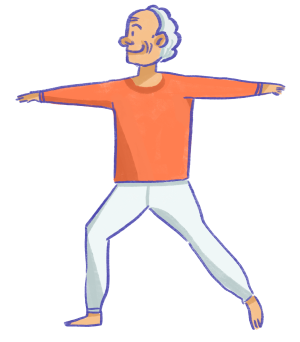The importance of fitness as we age
Exercise is important at every stage in life, but it becomes increasingly important as we age. Here we look at why fitness is important for your loved one and how you can help them start an exercise routine at any age.
Why is fitness important?
There are plenty of reasons it’s important for you and your older loved ones to exercise. Fitness and general physical activities reduce the risk of several diseases including type-2 diabetes and some cancers. Not enough exercise is a major contributing factor to heart disease. However, if you do more exercise, you can reduce your heart disease risk factors such as high blood pressure and cholesterol.
It can also decrease your loved one’s falls risk. Around one in three older Australians have experienced a fall in the past 12 months. Among the contributing factors to this increased risk is a deterioration in physical strength.
It’s not just for physical health either, research has found it can improve cognitive decline too. The University of Birmingham found that fitness in older people relates to a decrease in what we call ‘tip of the tongue’ moments. These are those moments when you can’t quite remember the name of someone or something.
The study recognised that some cognitive decline is an inevitable part of getting older. However, we can slow the decline and protect ourselves from a further decline in our language capabilities by staying fit.
How can you start an exercise routine?
If your loved one has pre-existing health issues, it’s important they talk to their GP before they start any exercise program. They will advise what type of exercise to choose and help build the routine up safely.
The next step is to consider what your loved one is likely to enjoy most and what will be easy to integrate into their routine. They could join a group activity or exercise together with a friend. Or you could get them some good earphones and use their exercise as a chance to listen to podcasts or audiobooks.
If you or your loved one haven’t done much exercise, it’s ok. The key is to start small. You can reduce your risk of heart disease by walking as little as 15 minutes a day. As you improve your fitness level, you can escalate it to 20 minutes, then 25 minutes, and so on.

What are some good exercises to try?
Walking
Walking is a low-impact exercise which is extremely beneficial in improving your health. In fact, if you walk for an average of 30 minutes or more a day, you can lower the risk of heart disease and stroke by 35% and Type 2 diabetes by 40%.
The benefit of walking is that most people can do it and you don’t need any special equipment. Walking temporarily increases your heart rate and blood pressure to get the heart pumping.
Start with 15 minutes of gentle walking and gradually build it up. You could join a walking group, which has the added benefit of giving you some socialisation. Or simply take a walk to the local shops or around the block.
Swimming
Swimming is another low impact exercise which has shown to improve health. The benefit of swimming is that it increases your heart rate while reducing impact stress on the body, making it an ideal exercise for people with arthritis and chronic conditions.
Swimming trains your body to use oxygen more effectively and helps decline the resting heart rate and breathing rate. It can also improve flexibility and improve muscle strength. One study found it improved body weight, body fat distribution, and LDL cholesterol levels better than walking did.
If you’re not confident doing laps, you could also try walking or running in water or even programs like aquarobics. You could also look into swimming lessons to increase your confidence and fitness in the water.
Cycling
Cycling is an aerobic exercise that can be especially beneficial for older people as it’s lower impact that doesn’t wear the joints.
Cycling improves your heart function by raising your metabolic rate and burning fat, which can keep your weight under control. Being overweight is a prime risk factor for developing heart disease.
There are many ways you or your loved one can incorporate cycling in your life. You could ride to the nearby shops instead of getting in the car or join a cycling group that goes on regular, leisurely bike rides around your area.
Strength training
You may have only considered aerobic training, however studies have found that combining aerobic and strength training can increase weight loss, fat loss and improve cardio-respiratory fitness.
Training with weights boosts your muscle to fat ratio, which means as you become stronger and build muscle, your body burns more fat when resting.
This results in maintaining a healthy body weight, which contributes to reducing the risk of heart disease. Not only does strength training improve heart health, but it strengthens your muscles, improves bone health and tones the body.
Yoga
Yoga is gentle and relaxing and it rarely increases your heart rate. However, it helps maintain good blood circulation throughout your body and it can reduce your blood pressure as it can help you stay calmer in times of stress.
Although it's daunting to try something new, you or your loved one could look into a local beginner yoga class.
Get some help if you need it
Light to moderate exercise is fine for most people, but if you feel any symptoms of discomfort, it’s important you stop and seek medical advice. These signs include:
- Chest pain
- Feeling faint
- Difficulty breathing
- Your heart beating irregularly or too fast
For more information on heart health and exercise, visit the Australian Heart Foundation.
